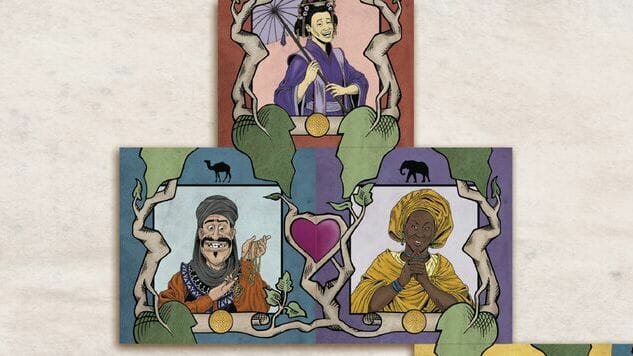Board Game Ancestree Plays Too Much Like Its Ancestors
Art courtesy of Calliope Games
Ancestree comes from Calliope Games’ Titan series, where experienced designers of heavier games offer lightweight designs for quick-playing games more in line with Calliope’s other titles. Its designer, Eric Lang, is best known for 2015’s Blood Rage, a medium-heavy game of dudes on a map with miniatures and a fantasy theme and card drafting and hand management and, yeah, it’s kind of a lot, so Ancestree’s short rule set and quick playing time is a pleasant surprise. It’s a nice filler game, but there’s a little too much here that’s familiar to any regular board gamers.
Ancestree’s gimmick is to have players build family trees of tiles that come in five colors and may have zero, one or two connecting branches on the top and on the bottom of each tile, allowing you to connect them to tiles on additional rows on your tableau. Some tiles also have half-hearts on one or both sides of the tile, allowing you to create ‘marriages’ by forming complete hearts with two adjacent tiles. You may only place a tile if you can connect a branch (top to bottom) or complete a heart (left to right).
The game takes place over three rounds, with players placing fifteen tiles each over the entire game. In a round, each player takes six face-down tiles at random from the general supply, then plays one to his/her family tree and passes the remaining tiles to the player to the left (rounds 1/3) or right (round 2). Players continue to place and pass until everyone has placed five tiles in the round, at which point the last tiles are discarded and the end-of-round scoring takes place.
At the end of each round, you compare your longest family line in each of the five colors to those of your neighbors to the left and to the right, and score 1, 2 or 3 points (depending on the round) if your line is longer. A family line must be connected vertically, and you count one tile in each color per row (“generations” in the game’s parlance). With five colors and two neighbors, you make ten comparisons in each round, 30 over the course of the game, and it’s really hard for anyone to run away with this aspect of the scoring. You’ll often end up with ties in several colors, where no one scores, especially after the first round, but by game-end every player should have 15 tiles in his/her family tree and there will be plenty of differences between neighboring players.
